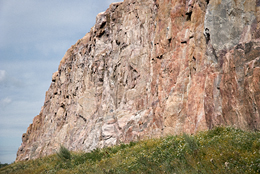back
 Natural museum
Natural museum
This is not the first time Book & Hedén have studied stones. In various respects, the 2001 project Bexell’s stenar (Bexell’s Stones), with its black and white photos of inscriptions in the forest, was the very opposite of Produced Landscapes. Alfred Bexell (1831–1900), son of a Swedish priest and a member of the Swedish parliament, owned and managed several farms, including Torstorp, with its adjacent woods, where in the 1880s and 90s he commissioned stonemasons to carve proverbs, maxims and the names of historical and contemporary figures into boulders and cliff faces out in the woods. Since 1925 the moss has been gradually cleared away to reveal more than 550 names of fallen soldiers, parliamentarians, geologists, palaeontologists, apothecaries, chemists and the like. Among the more curious inscriptions are the names of three Indian chiefs and a Zulu king. In one way or another, all of them were ahead of their time in combatting older attitudes and ways of thinking. Thus it might seem that Bexell possessed unusual foresight, and wanted his commemorative forest to forge a link between geological time – that of the stone – the time in which he lived, and a future when these people would be honoured.
For us this forest can seem like a sentimental collection of memorials – a romantic attempt to get the stones themselves to speak. Bexell’s curious work was in the spirit, on the one hand, of an ancient tradition of ecphrasis, whereby the artist yearned to coax language from dead material in the firm belief that stones had the power to record the passing of an age and to share their message, and on the other, of the late 19th century picturesque park tradition that administrated nature by installing within it the traces of civilization. People laid out paths that led to panoramic observation points, they built garden pavilions and entire farmsteads, they designed parks specially for the promenader and his gaze. Bexell for his part created what was also a natural museum based on a temporal and material encounter between the slow time of geology and the transitoriness of humanity and its history. Thus we might well infer that he sought to convert historical time into the glacially slow time of stone – to capture and preserve it for time to come.
The road cuttings along the E6 are different in every conceivable way. What we see in this series of pictures is an ordinary and non-mythical landscape. It is observed at speed, not during a leisurely promenade through a natural landscape. And what makes the cuttings legible for us is the violent, one might even say brutal, blasting-to-pieces of solid rock that would otherwise be lying under the ground, covered by grass, moss, trees and bushes – a typical tract of Norwegian forest. This, and the camera’s freezing and framing of the cuttings. Stone is the most lifeless, least legible material in nature. Its patterns have no intention and we have no access to the slow geological time, the laborious shaping of the earth that it represents. The speed of the car at no time allows us to imagine that we are in contact with the landscapes we traverse. It is the camera that makes the illegible legible. It is the camera that reveals the materiality of these road cuttings. But in doing so it also reveals a time to which we have no access – that slow time of the slowly evolving earth.
When Bexell’s stones are being photographed, as a museum, his own time is made to coincide with that of the stones; both had been excavated from beneath the moss. The road cuttings on the other hand can be regarded as an offence against the stone’s temporality. The cut or incision into the mountain, which we don’t really see when passing at speed but is all the clearer when frozen by the camera, challenges the lethargy and ponderousness of the stone. By slicing through a stretch or rock, mechanically and blindly, the road cutting ignores the hyper-slow development of our geological environment. In other words, the focal interest in these pictures is the encounter between a slow geological process and a fleeting perception of material. They provide access to a temporality and a materiality that is usually snatched away by the rapid tempo of our lives. These road cuttings are evidence and proof of a need to see time once again.
